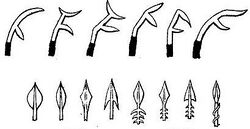Engineering:Mambele
A mambele is a form of hybrid knife/axe in central and southern Africa, originating from a curved throwing dagger used by the Mangbetu.[citation needed]
Description
The mambele consists of an iron blade with a curved back section and rearward spike. It can be used in close combat as a hatchet or dagger, or more typically as a throwing weapon. It usually consists of four blades, three on top and one on the side. The curved hook was used to keep the weapon in the victim, and if pulled out, caused further damage. It would have been about 56 cm (22 in) in length.[citation needed] These African iron weapons are thrown with a rotatory motion, and can inflict deep wounds with their projecting blades.
The mambele is also known as:
- Hunga Munga[1]
- Danisco by the Marghi[citation needed][2]
- Goleyo by the Musgum[3]
- Njiga by the Bagirmi[citation needed]
- Kpinga by the Zande. They were classed as "Court Metal", being produced under the patronage of the Avongara clan, distributed only to professional warriors, and considered status symbols. It was also part of the dowry that a man must pay to the bride's family.[4] Soldiers would carry three or four[clarification needed] into battle, hidden behind their shields. They were typically thrown at the enemy from 9 m (30 ft) away.[5]
They vary constantly in form and their use extends across Africa, from the Upper Nile on the east through Central Africa and over to Gabon in West Africa. The “musri” or “mouzeri” throwing knife of the Teda peoples in the central Sahara is a variant. In parts of Central Africa these weapons assume the form of a bird's head.[6]
These knives reflect the culture of Africa before western colonisation, both through their design and use. They can be symmetrical, bulbous, or even multi-pronged. Many are made of rarer and softer materials. These were harder to forge and were a status symbol to their owners.
See also
References
- ↑ Wood, A. J. (2018-09-04). Human world : a visual compendium of wonders from human history. Jolley, Mike,, Lozano, Andrés. Minneapolis, MN. pp. 82. ISBN 9781847809926. OCLC 1021808923.
- ↑ Cowper, H.S (2012-03-30) (in English). The Art of Attack and the Development of Weapons. Andrews UK Limited. ISBN 9781781503591. https://books.google.com/books?id=s2S-BAAAQBAJ&q=danisco+by+the+Marghi.
- ↑ "Chapter 12: Jua Cheza - Path of the Invincible Dragon" (in en). 5 May 2021. https://www.royalroad.com/fiction/42058/path-of-the-invincible-dragon/chapter/676741/chapter-12-jua-cheza.
- ↑ "Kpinga". Pitt-Rivers Museum. http://web.prm.ox.ac.uk/weapons/index.php/tour-by-region/africa/africa/arms-and-armour-africa-18/index.html.
- ↑ Thompson, Avery (September 15, 2017). "This Three-Bladed Throwing Knife Will Never Miss". http://www.popularmechanics.com/military/weapons/a28235/three-bladed-throwing-knife-kpinga/.
- ↑ "Central Africa | History, Countries, Climate, & Facts | Britannica" (in en). https://www.britannica.com/place/central-Africa.
External links
- Poppe, Guido T. Collection of mambeles, Belgium
 |




